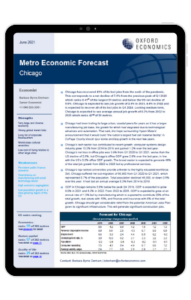US | Metro Economic Forecast: Chicago

Chicago has recovered 41% of its lost jobs from the nadir of the pandemic. This corresponds to a net decline of 7.5% from the previous peak of Q1 2020 which ranks it 41st of the largest 51 metros and below the US net decline of 5.6%. Chicago is expected to see job growth of 2.4% in 2021, 4.4% in 2022 and is expected to recover all of its lost jobs in Q1 2024. Looking medium term, Chicago is expected to see average annual job growth of 0.3% from 2022 to 2025 which ranks 42nd of 51 metros.
What you will learn:
- Chicago had been trailing its large urban, coastal peers for years as it has a larger manufacturing job base, the growth for which had stagnated due to technological advances and automation. That said, the hope surrounding Hyzon Motors’ announcement that it would build “the nation’s largest fuel cell material facility” in DuPage County should spur some ancillary growth in the next few years.
- Chicago’s tech sector has contributed to recent growth: computer systems design industry grew 13.2% from 2014 to 2019 and gained 1.2% over the last year. Chicago’s net loss in office jobs was 3.9% from Q1 2020 to Q1 2021, worse than the US decline of 2.5%, but Chicago’s office GDP grew 2.8% over the last year, in line with the US’s 3.2% office GDP growth.
- Chicago’s top-ranked universities provide a feeder to the highly educated workforce. Still, Chicago suffered net out-migration of 68,900 from Q1 2020 to Q1 2021, which represented 0.7% of the population. Total population declined 46,000, or down 0.5% over the year. It had lost an annual average 0.2% from 2014 to 2019.
Tags:
Related Services

Post
House prices continue to slide for China’s cities
Research Briefing US | Metro Economic Forecast: Chicago While the property market downturn has been universal, the scale and depth has been varied for different cities and regions.
Find Out More
Post
The Construction Productivity Challenge in Australia
Delve into the state of construction productivity in Australia. Understand the factors affecting growth and how innovation can transform the industry for the better.
Find Out More